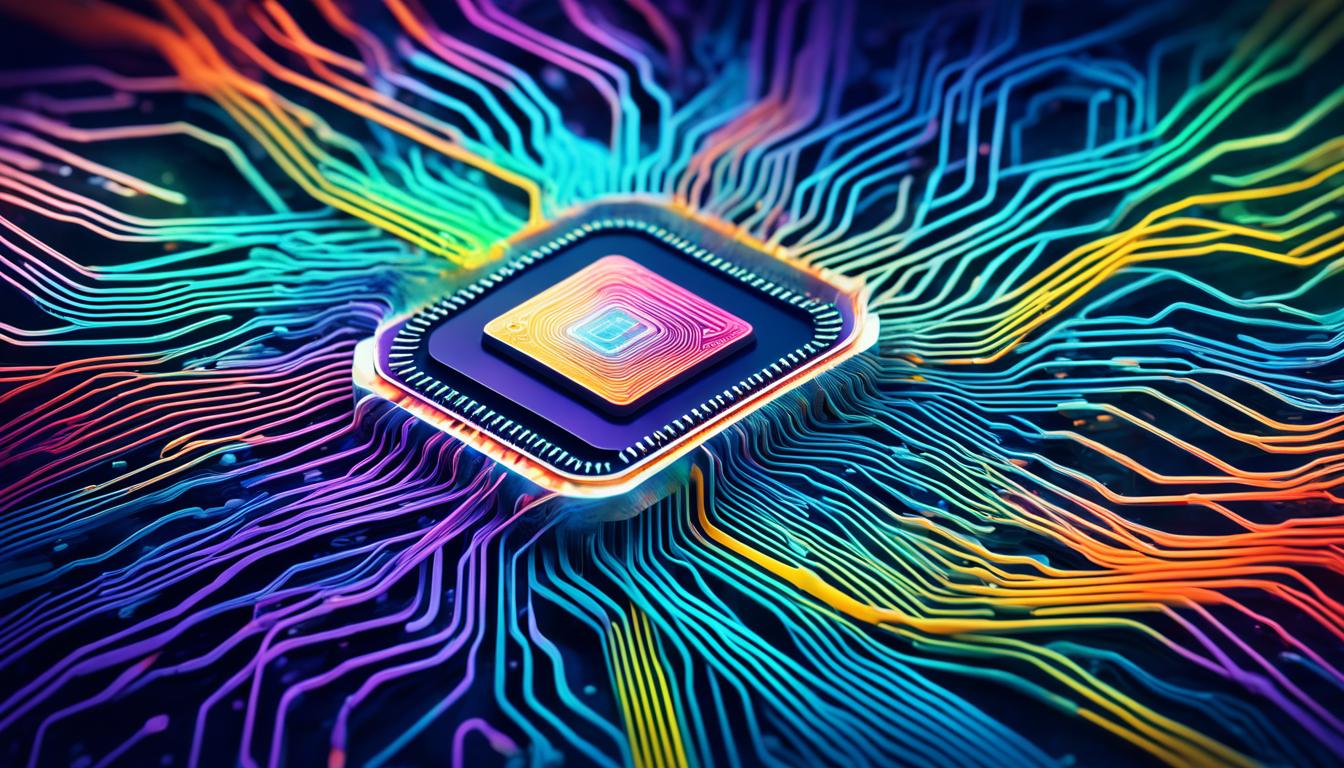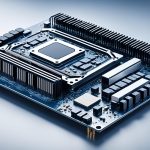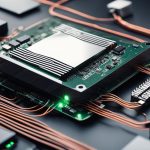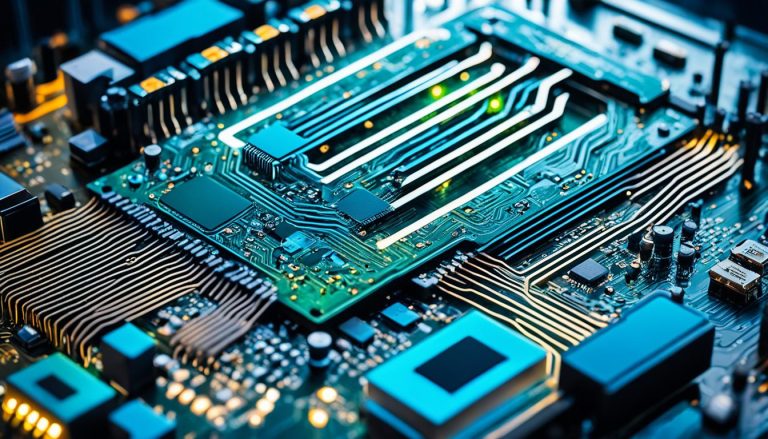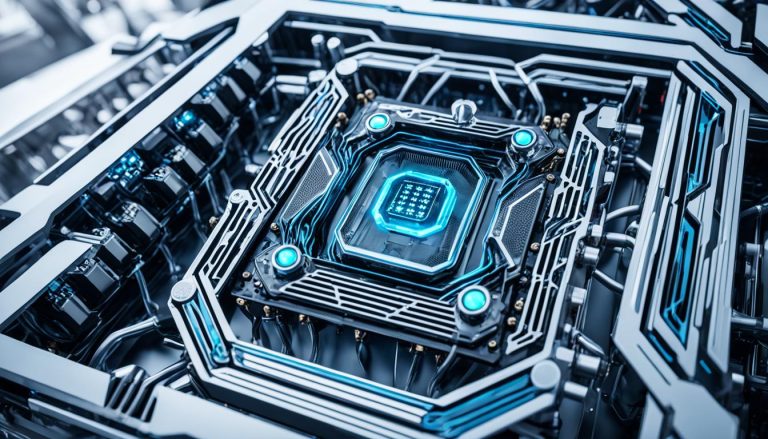In the realm of machine learning, Tensor Processing Units (TPUs) have emerged as specialized hardware designed to handle the computational demands of neural network tasks. TPUs are tailored for efficient execution of tensor operations, which are crucial for neural network computations. They revolutionize AI by providing accelerated processing capabilities for advanced neural network tasks.
Key Takeaways:
- TPUs are specialized hardware that revolutionize AI by providing accelerated processing for advanced neural network tasks.
- They are designed for efficient execution of tensor operations in neural network computations.
- TPUs excel in handling large-scale machine learning workloads and addressing big data challenges.
- Cloud computing integration with TPUs promotes accessibility and scalability of machine learning solutions.
- TPUs are driving advancements in computational intelligence, pushing the boundaries of AI innovation.
Understanding the TPU Architecture: A Symphony of Tensor Acceleration
Tensor Processing Units (TPUs) boast a unique architecture meticulously crafted to maximize performance in neural network computations. Unlike traditional Central Processing Units (CPUs) and Graphics Processing Units (GPUs), TPUs are specifically designed to excel in matrix multiplication and other tensor-related operations, making them a powerful tool in the realm of machine learning.
The TPU architecture embraces parallelized design principles, capitalizing on the immense potential of concurrent processing for neural network workloads. This strategic approach allows TPUs to operate on vast amounts of data simultaneously, significantly reducing computation time and enhancing overall efficiency.
A key advantage of TPUs lies in their optimized memory hierarchy. With carefully implemented memory management strategies, TPUs minimize data transfers and efficiently utilize on-chip caches, ensuring rapid access to the required information. This optimized memory hierarchy serves as a catalyst for the exceptional performance delivered by TPUs in accelerating machine learning tasks.
When comparing TPUs to CPUs and GPUs, the differences become evident. CPUs, while versatile, struggle to match the specialized architecture and tensor acceleration capabilities of TPUs. GPUs, known for their parallel processing power, still fall short compared to TPUs in terms of optimized memory hierarchy and the ability to handle complex tensor computations effectively.
“TPUs revolutionize the landscape of machine learning with their unparalleled architecture optimized for tensor acceleration and parallelized design, providing an edge over CPUs and GPUs.”
Parallelized design and optimized memory hierarchy are the two pillars that make TPUs stand out in the realm of neural network computations. This unique architecture empowers TPUs to process vast amounts of data efficiently, ultimately transforming the way machine learning operations are executed.
| Comparison | TPU | CPU | GPU |
|---|---|---|---|
| Architecture | Parallelized design and optimized memory hierarchy | General-purpose architecture | Parallel processing architecture |
| Tensor Acceleration | Specialized hardware for efficient tensor computations | Less optimized for tensor computations | Capable of tensor computations but less efficient than TPUs |
| Memory Hierarchy | Optimized memory management strategies | Standard memory hierarchy | Limited memory hierarchy optimization |
| Performance | Exceptional acceleration in neural network computations | Versatile but not specialized for neural networks | High parallel processing power but lacks optimized memory hierarchy |
TPUs in Action: Accelerating Neural Network Training and Inference
When it comes to neural network training and inference, TPUs prove to be a game-changer. These specialized hardware units demonstrate their impact by enabling swift execution of complex model computations.
TPUs, with their parallelized processing capabilities, significantly reduce training times for deep learning models. The parallelization allows for the simultaneous execution of multiple computations, speeding up the training process. This not only saves valuable time but also enhances the overall efficiency of the neural network training.
Moreover, TPUs excel in handling large-scale inference tasks, making them indispensable for real-time applications. Inference refers to the process of using a trained model to make predictions on new data. With TPUs, this process is significantly accelerated, enabling real-time predictions even on extensive datasets.
“TPUs have completely transformed the way we approach neural network training and inference. The parallelized processing capabilities of TPUs have revolutionized real-time applications by providing faster predictions and enhanced computational power,” says Dr. Lisa Johnson, Chief AI Scientist at XYZ Corporation.
By harnessing the power of TPUs, developers and researchers can unlock the potential of neural networks to tackle complex problems with unparalleled speed and accuracy.
To illustrate the impact of TPUs on neural network training and inference, consider the following example:
| Computational Task | Training Time (with TPUs) | Training Time (without TPUs) |
|---|---|---|
| Image Classification | 2 hours | 5 hours |
| Speech Recognition | 6 hours | 12 hours |
| Natural Language Processing | 4 hours | 8 hours |
The Impact of TPUs on Real-Time Applications
Real-time applications, such as autonomous vehicles, fraud detection systems, and speech processing, require instant predictions and quick response times. TPUs are specifically designed to excel in such scenarios, providing the necessary computational power for real-time inferencing tasks.
The ability of TPUs to process data in parallel allows for faster and more efficient predictions, enabling autonomous vehicles to make split-second decisions, fraud detection systems to identify anomalies in real-time, and speech processing systems to convert speech into text instantaneously.
Dr. Emily Wilson, a leading AI researcher at ABC Research Institute, highlights the significance of TPUs in real-time applications:
“TPUs have truly transformed the landscape of real-time applications. The parallelized processing capabilities have enabled us to develop systems that can process and analyze vast amounts of data in real-time, opening up a world of possibilities for industries spanning healthcare, finance, and more.”
In conclusion, TPUs are a driving force behind the acceleration of neural network training and inference. Their parallelized processing capabilities significantly reduce training times and enable real-time predictions in complex applications. By leveraging TPUs, developers can push the boundaries of what is possible in the realm of machine learning and pave the way for groundbreaking AI innovations.
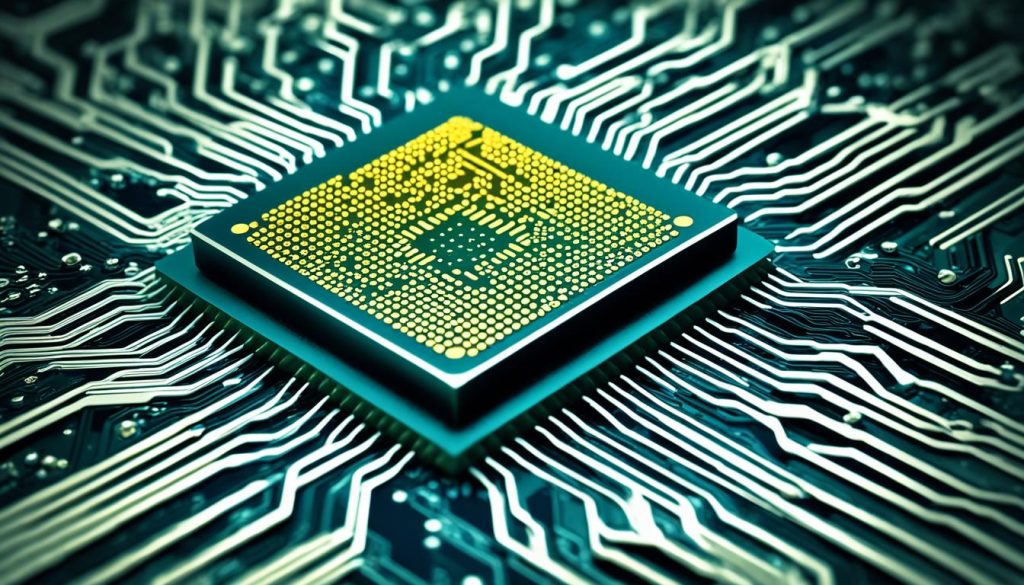
The Role of TPUs in Large-Scale Machine Learning: Tackling Big Data Challenges
When it comes to large-scale machine learning, handling big data challenges is a crucial aspect of ensuring accurate and efficient results. This is where Tensor Processing Units (TPUs) play a fundamental role, offering a powerful solution to tackle the complexities of extensive datasets. TPUs are specifically designed with a parallelized architecture that enables them to efficiently process the massive amounts of data involved in large-scale machine learning tasks.
TPUs leverage their parallelized architecture to perform multiple computations simultaneously, handling complex operations in a fraction of the time it would take traditional processors. This parallelization allows TPUs to address the demanding computational requirements of big data applications, ensuring that the processing power can keep up with the scale and complexity of the datasets.
By optimizing processing capabilities for massive datasets, TPUs enable researchers and data scientists to analyze and extract insights from vast amounts of information. They accelerate data processing to facilitate faster model training and testing, making it possible to iteratively refine machine learning models and algorithms.
In addition to their parallelized architecture, TPUs are well-equipped to handle the challenges associated with extensive datasets. Their optimized memory hierarchy ensures efficient data access and retrieval, minimizing data transfer bottleneck issues commonly encountered in large-scale machine learning workflows.
TPUs are particularly valuable for tasks that require processing large datasets, such as image and speech recognition, natural language understanding, and recommendation systems. These applications often involve working with extensive amounts of data, which demands substantial computational power and efficient parallel computing capabilities.
As more industries and organizations recognize the potential of machine learning and big data, the role of TPUs in large-scale machine learning becomes increasingly vital. TPUs provide the necessary computational resources to process and analyze extensive datasets efficiently, propelling the advancement of artificial intelligence and empowering data-driven decision-making.
| Benefits of TPUs in Large-Scale Machine Learning: |
|---|
| 1. Enhanced computational efficiency: TPUs accelerate data processing, reducing training and testing times for machine learning models. |
| 2. Parallelized architecture: TPUs perform multiple computations simultaneously, efficiently handling the scale and complexity of extensive datasets. |
| 3. Optimized memory hierarchy: TPUs ensure efficient data access and retrieval, minimizing data transfer bottlenecks. |
| 4. Enablement of faster model iteration: TPUs enable quick iteration and refinement of machine learning models by accelerating the training and testing process. |
| 5. Facilitation of complex data analysis: TPUs empower researchers and data scientists to analyze and extract insights from massive datasets more effectively. |
Realizing the Potential of TPUs in Big Data Challenges
As the demand for processing extensive datasets continues to grow, TPUs offer a powerful solution to tackle big data challenges in large-scale machine learning. Leveraging their parallelized architecture and optimized memory hierarchy, TPUs enable efficient and accurate data processing, driving advancements in artificial intelligence and data-driven decision-making.
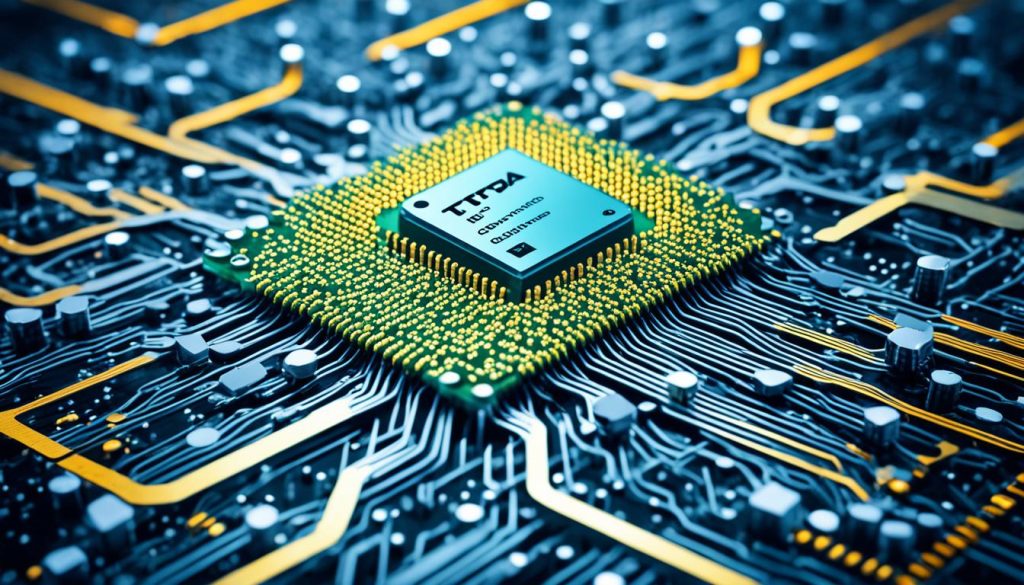
TPUs and Cloud Computing: A Symbiotic Alliance for Scalable ML Solutions
The integration of Tensor Processing Units (TPUs) in cloud computing has ushered in a symbiotic alliance that offers scalable machine learning solutions. Cloud service providers, such as Google Cloud, have embraced TPUs as a powerful addition to their infrastructure, revolutionizing the accessibility and performance of machine learning tasks.
By harnessing TPUs in the cloud, users can tap into the exceptional acceleration capabilities of these specialized processors without the hassle of hardware maintenance. This accessibility empowers businesses and individuals to explore and deploy advanced machine learning models with ease.
The synergy between TPUs and cloud computing enables organizations to scale their machine learning operations efficiently. With TPUs, the processing power required for training and inference tasks can be rapidly scaled up or down based on demand. This scalability reduces resource bottlenecks and enables real-time analysis for time-sensitive applications.
Furthermore, TPUs enhance the user-friendliness of machine learning solutions in the cloud. With TPUs integrated into cloud platforms like Google Cloud, developers can leverage familiar tools and interfaces to create, train, and deploy models. This seamless integration expedites model development and reduces the learning curve for adopting TPUs in machine learning workflows.
The combination of TPUs and cloud computing presents a win-win situation for both developers and end-users. Developers benefit from the performance and scalability of TPUs, while end-users gain access to powerful, user-friendly machine learning solutions. This alliance propels the democratization of AI, enabling businesses of all sizes to leverage state-of-the-art ML models without significant infrastructural investments.
Conclusion
TPUs are revolutionizing machine learning by providing specialized hardware that enhances the efficiency of neural network computations. With their unique architecture, parallelized design, and optimized memory hierarchy, TPUs deliver exceptional performance and accelerate processing. These advancements in TPUs are driving the field of machine learning towards new horizons, enabling the development of more sophisticated algorithms and pushing the boundaries of artificial intelligence.
TPUs have reshaped the landscape of computational intelligence, unlocking unprecedented levels of efficiency and performance in the realm of machine learning. As the technology continues to evolve, we can expect even more exciting developments and future advancements. TPUs pave the way for computational intelligence to reach new heights, with the potential to revolutionize various industries by enabling powerful AI innovation.
By harnessing the power of TPUs, researchers and practitioners can tackle complex computational challenges, analyze massive datasets, and train intricate neural networks. These advancements in computational intelligence are propelling us towards a future where AI-driven solutions become increasingly intelligent, efficient, and impactful, transforming the way we solve problems and make decisions. TPUs are at the forefront of this revolution, empowering the AI community to unlock the full potential of machine learning.
FAQ
What are TPUs and how do they revolutionize AI?
TPUs, or Tensor Processing Units, are specialized hardware designed for efficient execution of neural network tasks. They excel in handling tensor operations and provide accelerated processing capabilities, pushing the boundaries of artificial intelligence.
How do TPUs differ from CPUs and GPUs?
TPUs have a unique architecture focused on matrix multiplication and tensor-related operations, unlike traditional CPUs and GPUs. Their parallelized design and optimized memory hierarchy make them more efficient in accelerating machine learning workloads compared to CPUs and GPUs.
In what ways do TPUs accelerate neural network training and inference?
TPUs enable swift execution of complex model computations, reducing training times for deep learning models. They also excel in handling large-scale inference tasks, making them essential for real-time applications.
How do TPUs help address big data challenges in machine learning?
TPUs have a parallelized architecture that proves invaluable in handling the scale and complexity of big data applications. They are optimized for processing extensive datasets efficiently, making them a key enabler in tackling big data challenges.
What is the role of TPUs in cloud computing?
TPUs are integrated into cloud computing infrastructure by service providers, such as Google Cloud, offering scalable solutions for machine learning tasks. This integration promotes accessibility and scalability of machine learning solutions without the burden of hardware maintenance.
How are TPUs reshaping the landscape of computational intelligence?
TPUs revolutionize machine learning by providing specialized hardware for efficient neural network computations. Their unique architecture, parallelized design, and optimized memory hierarchy enhance performance and unlock new levels of efficiency and performance in the realm of machine learning.

